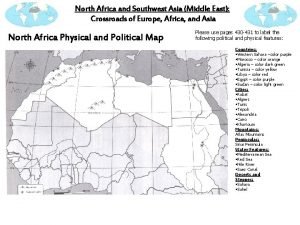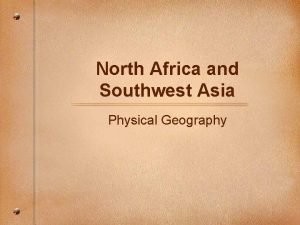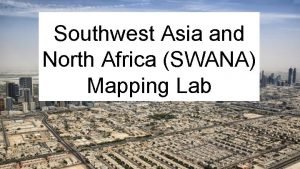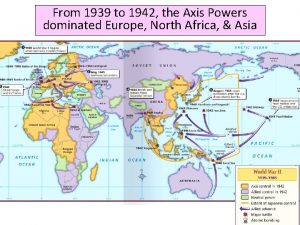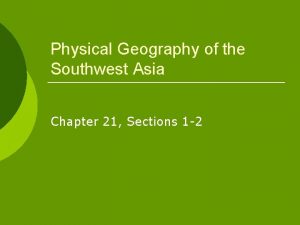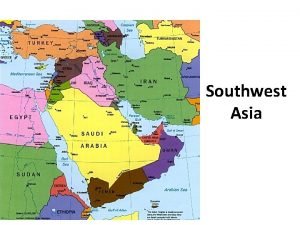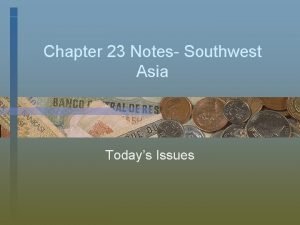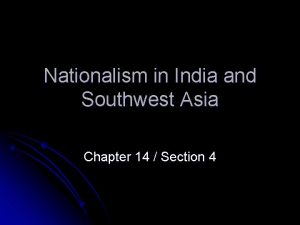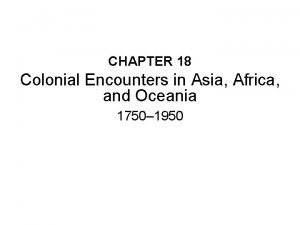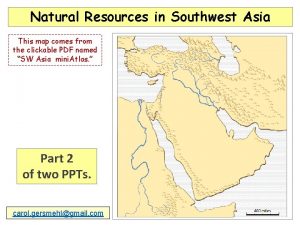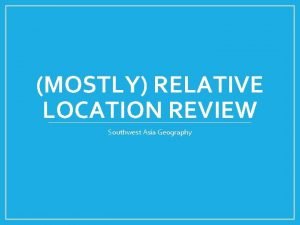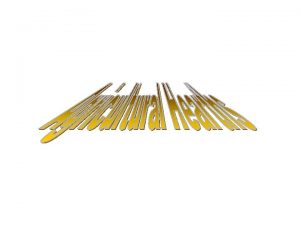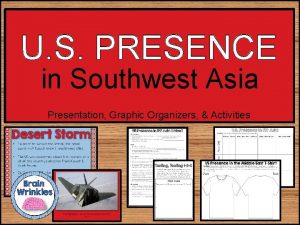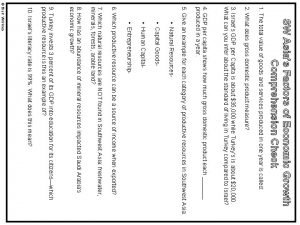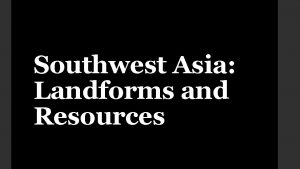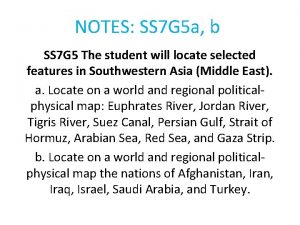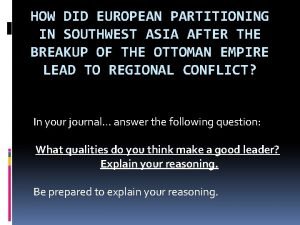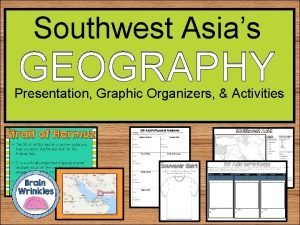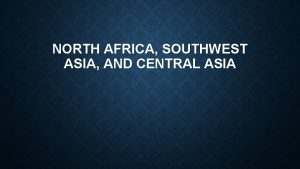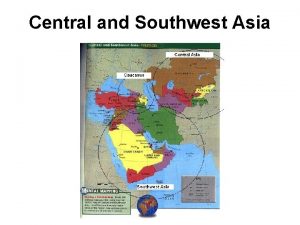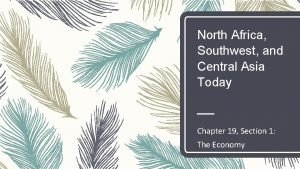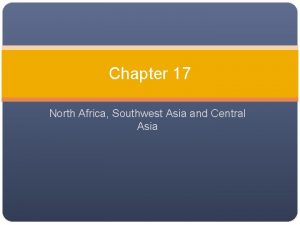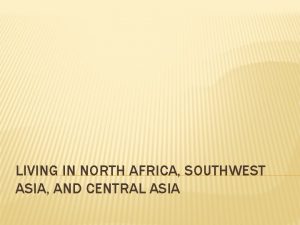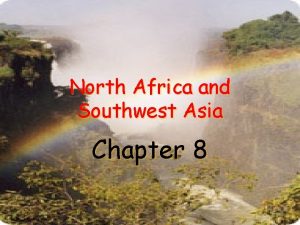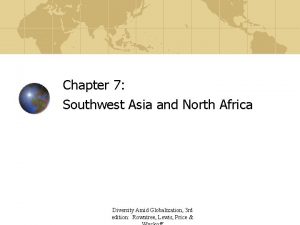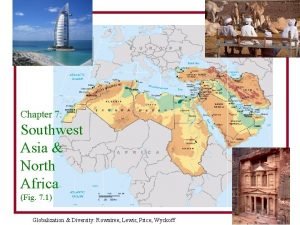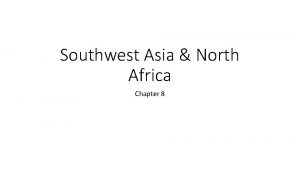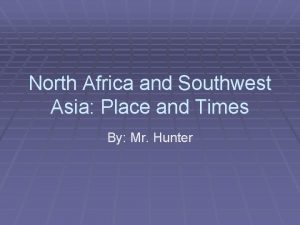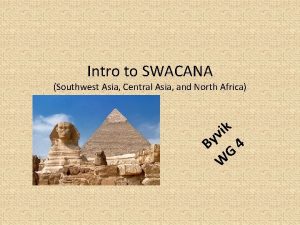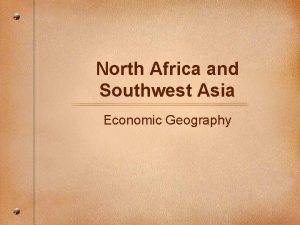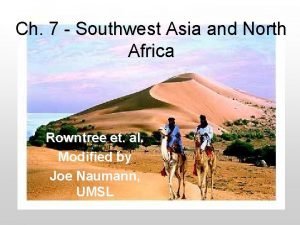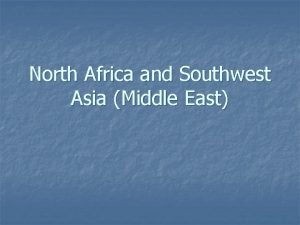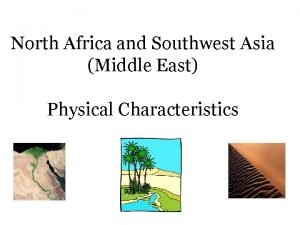Chapter 19 North Africa Southwest and Central Asia






























- Slides: 30

Chapter 19 North Africa, Southwest and Central Asia Today


Chapter Objectives �Describe ways of life in North Africa, Southwest Asia, and Central Asia. �Discuss efforts to improve the region’s supply of freshwater and to meet environmental challenges.

Living in North Africa, Southwest Asia, and Central Asia Section 1

Section Objectives �Discuss how physical geography affects farming and fishing in North Africa, Southwest Asia, and Central Asia. �List the region’s important industries. �Explain how improvements in transportation and communications are changing life in the region.

Terms to Know �Arable �commodity �petrochemical �gross domestic product (GDP) �hajj �embargo

A Geographic View

Geographic Literacy �In 1999 the United States imported nearly $42 billion worth of petroleum products from the Organization of Petroleum Exporting Countries (OPEC). Most of the 11 OPEC countries are in Southwest Asia or North Africa. OPEC countries make an enormous profit from their trade with the United States; they imported only $20 billion worth of goods and services from the United States in 1999.

Meeting Food Needs. �Producing food for a rapidly growing population is a challenge in many parts of the region. �More developed countries, such as Saudi Arabia, use oil profits to import food. �Less developed countries, such as Afghanistan, often grow their own food despite small yields. �Agriculture Only a small part of the region’s land is farmable, but many people work in agriculture. �Grains and fruit are important crops. Livestock, cotton, silkworms, and tea are also important to certain areas.

Meeting Food Needs �Fishing is a major industry that provides an important source of food. �The Persian Gulf has about 150 edible species of fish.

Industrial Growth �Oil, Natural Gas, and Mining North Africa, Southwest Asia, and Central Asia supplies much of the world’s petroleum. �Iran and Saudi Arabia have developed oil-refining and oil-shipping facilities. �In some countries, natural gas supports manufacturing, and mining provides export income.

Service Sector �Service Industries and tourism play a large part in some of the region’s economies. �North Africa and Southwest Asia are favorite tourist destinations. �Religious conflicts and political instability, however, have discouraged tourism in some countries.

Transportation and Communication �Roads, Railroads, and Airlines Iran, Turkey, and Egypt are crisscrossed by extensive highway systems. �Mountains and deserts in some countries pose obstacles to road construction. �Rapid transit systems are beginning to appear in cities such as Istanbul. �Since the breakup of the Soviet Union, Central Asian countries have set up their own airlines.

Transportation and Communication �Waterways and Pipelines The region’s economies depend heavily on water transportation. �Merchant traffic, such as oil tankers, enters and leaves through the Strait of Tiran, between the Gulf of Aqaba and the Red Sea, or the Strait of Hormuz, linking the Persian Gulf with the Arabian Sea. �The Suez Canal, lying between the Sinai Peninsula and the rest of Egypt, enables ships to pass from the Mediterranean Sea to the Red Sea. �Pipelines carry oil from its sources to various ports on the Mediterranean and Red Seas and the Persian Gulf.

Transportation and Communication �Communications Television and radio broadcasting is expanding, and satellite technology is improving communications. Many people in major cities rely on cellular phones for communication. �In 1998 over 16, 000 miles of cable were laid along the route of the ancient Silk Road, providing digital access to 20 countries.

Transportation and Communication

Interdependence � Wealthier countries in the region, such as Saudi Arabia, are helping developing countries, such as the Central Asian republics. Aid includes trade deals and development loans. � The Organization of Petroleum Exporting Countries (OPEC) includes eight countries in the region. � OPEC has given its members control over oil prices and production rates. � Because other countries depend heavily on the region’s oil, OPEC has considerable world power and influence. � Industrialized countries like the United States depend on oil from the region, and the region depends on the export of this product.

People and Their Environment Section 2

Section Objectives �Describe how the peoples in North Africa, Southwest Asia, and Central Asia have dealt with scarce water resources. �Discuss the causes and effects of environmental problems in the region.

Terms to Know �Aquifer �Desalination

A Geographic View

Geographic Literacy Egypt’s Suez Canal links the Mediterranean Sea and the Red Sea. The canal is 121 miles (195 km) long and was built by a French corporation, with Egyptian labor, between 1859 and 1869. Great Britain took over control of the canal six years later. In 1956, the last British troops departed, and Egypt now controls the Suez Canal.

The Need for Water �Water Resources North Africa, Southwest Asia, and Central Asia have limited sources of freshwater. �Much of it comes from rivers, oases, and aquifers. �Only a few countries have enough water for irrigation. � Desalination One solution to limited water resources is desalination–the removal of salt from seawater. �The region’s desalination plants produce about 2. 4 billion gallons (9. 1 billion liters) of water per day.

The Need for Water �An Ancient Solution - Ancient Nabataeans, who lived in what is now Jordan, “harvested” rainwater, storing it in a system of pipes and cisterns for use throughout the year. �Libya’s “great man-made river” is an ambitious project to supply freshwater. �Two pipelines carry water from large aquifers beneath the Sahara to farms near the Mediterranean coast.

Environmental Concerns �The Aswan High Dam, 600 miles south of Cairo, irrigates 3 million acres (1. 2 million ha) of land provides nearly half of Egypt’s electric power. �It also has created the world’s largest artificial lake. �The dam, however, has blocked the Nile’s natural process of depositing fertile soil and washing salt from the soil when it floods each year. Farmers now must fertilize the soil by other means.

Environmental Concerns

Environmental Concerns �The Persian Gulf War and the War in Iraq have had a negative effect on the environment. �During the Persian Gulf War of 1991, Iraqi troops retreating from Kuwait set fire to oil wells and dumped about 250 million gallons (947 million liters) of oil into the Persian Gulf. �Nuclear and Chemical Dangers - Central Asian countries have inherited the Soviet era’s environmental problems.

Environmental Concerns �The Caspian, Dead, and Aral Seas face environmental challenges. �Pollution and overfishing threaten fish in the Caspian Sea. �The Dead Sea’s water level has dropped drastically over the past 40 years because water has been diverted for irrigation and hydroelectric plants. �The Aral Sea has had water diverted from feeder rivers to irrigate cropland.

Section 1 - Summary �Although North Africa, Southwest Asia, and Central Asia have limited arable land, a relatively large percentage of the region’s people work in agriculture. �The oil-producing countries in North Africa, Southwest Asia, and Central Asia have experienced greater economic growth than other countries in the region.

Section 2 - Summary �Expanded and more advanced transportation and communications systems are helping connect the region’s urban and economic centers with one another and with the world. �Interdependence is increasing among the countries of the region, especially in controlling oil production and prices.
 Southwest asia
Southwest asia Political map of north africa and southwest asia
Political map of north africa and southwest asia North africa and southwest asia physical geography
North africa and southwest asia physical geography North africa southwest asia physical map
North africa southwest asia physical map North africa and southwest asia mountains
North africa and southwest asia mountains Southwest asia/north africa (swana) political map
Southwest asia/north africa (swana) political map Who dominated europe, north africa and asia from 1939-1942?
Who dominated europe, north africa and asia from 1939-1942? America asia africa
America asia africa Chapter 22 human geography of southwest asia
Chapter 22 human geography of southwest asia Chapter 21 physical geography of southwest asia
Chapter 21 physical geography of southwest asia Peninsulas and waterways in southwest asia
Peninsulas and waterways in southwest asia Chapter 23 today's issues southwest asia
Chapter 23 today's issues southwest asia Nationalism in india and southwest asia
Nationalism in india and southwest asia Judaism vs christianity vs islam venn diagram
Judaism vs christianity vs islam venn diagram Nationalism in india and southwest asia
Nationalism in india and southwest asia Nationalism in india and southwest asia
Nationalism in india and southwest asia Chapter 18 colonial encounters in asia and africa
Chapter 18 colonial encounters in asia and africa Brain wrinkles southwest asia
Brain wrinkles southwest asia Asia landforms
Asia landforms Natural resources of southwest asia
Natural resources of southwest asia What is the relative location of southwest asia?
What is the relative location of southwest asia? Fertile crescent
Fertile crescent Brain wrinkles southwest asia answer key
Brain wrinkles southwest asia answer key Somebody wanted but so us presence in sw asia
Somebody wanted but so us presence in sw asia Se asian economies comprehension check answer key
Se asian economies comprehension check answer key Ethnic groups coat of arms
Ethnic groups coat of arms Southwest asia landforms
Southwest asia landforms Tigris river on world map
Tigris river on world map Nationalism in southwest asia
Nationalism in southwest asia Europe partitioning in southwest asia answer key
Europe partitioning in southwest asia answer key Which physical features make trade easier?
Which physical features make trade easier?

